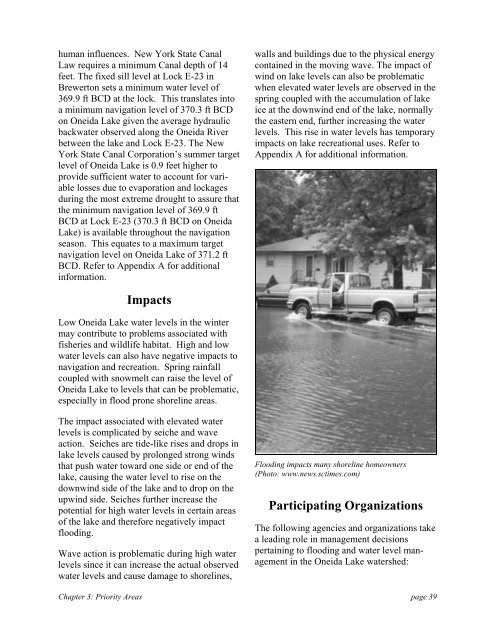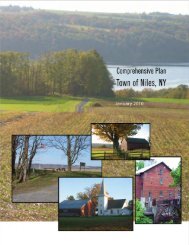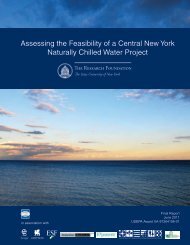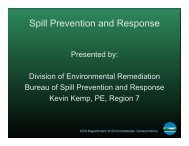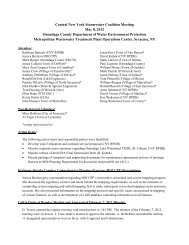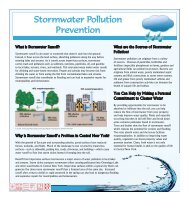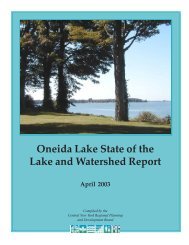A Management Strategy for Oneida Lake and its ... - CNY RPDB Home
A Management Strategy for Oneida Lake and its ... - CNY RPDB Home
A Management Strategy for Oneida Lake and its ... - CNY RPDB Home
Create successful ePaper yourself
Turn your PDF publications into a flip-book with our unique Google optimized e-Paper software.
human influences. New York State Canal<br />
Law requires a minimum Canal depth of 14<br />
feet. The fixed sill level at Lock E-23 in<br />
Brewerton sets a minimum water level of<br />
369.9 ft BCD at the lock. This translates into<br />
a minimum navigation level of 370.3 ft BCD<br />
on <strong>Oneida</strong> <strong>Lake</strong> given the average hydraulic<br />
backwater observed along the <strong>Oneida</strong> River<br />
between the lake <strong>and</strong> Lock E-23. The New<br />
York State Canal Corporation’s summer target<br />
level of <strong>Oneida</strong> <strong>Lake</strong> is 0.9 feet higher to<br />
provide sufficient water to account <strong>for</strong> variable<br />
losses due to evaporation <strong>and</strong> lockages<br />
during the most extreme drought to assure that<br />
the minimum navigation level of 369.9 ft<br />
BCD at Lock E-23 (370.3 ft BCD on <strong>Oneida</strong><br />
<strong>Lake</strong>) is available throughout the navigation<br />
season. This equates to a maximum target<br />
navigation level on <strong>Oneida</strong> <strong>Lake</strong> of 371.2 ft<br />
BCD. Refer to Appendix A <strong>for</strong> additional<br />
in<strong>for</strong>mation.<br />
walls <strong>and</strong> buildings due to the physical energy<br />
contained in the moving wave. The impact of<br />
wind on lake levels can also be problematic<br />
when elevated water levels are observed in the<br />
spring coupled with the accumulation of lake<br />
ice at the downwind end of the lake, normally<br />
the eastern end, further increasing the water<br />
levels. This rise in water levels has temporary<br />
impacts on lake recreational uses. Refer to<br />
Appendix A <strong>for</strong> additional in<strong>for</strong>mation.<br />
Impacts<br />
Low <strong>Oneida</strong> <strong>Lake</strong> water levels in the winter<br />
may contribute to problems associated with<br />
fisheries <strong>and</strong> wildlife habitat. High <strong>and</strong> low<br />
water levels can also have negative impacts to<br />
navigation <strong>and</strong> recreation. Spring rainfall<br />
coupled with snowmelt can raise the level of<br />
<strong>Oneida</strong> <strong>Lake</strong> to levels that can be problematic,<br />
especially in flood prone shoreline areas.<br />
The impact associated with elevated water<br />
levels is complicated by seiche <strong>and</strong> wave<br />
action. Seiches are tide-like rises <strong>and</strong> drops in<br />
lake levels caused by prolonged strong winds<br />
that push water toward one side or end of the<br />
lake, causing the water level to rise on the<br />
downwind side of the lake <strong>and</strong> to drop on the<br />
upwind side. Seiches further increase the<br />
potential <strong>for</strong> high water levels in certain areas<br />
of the lake <strong>and</strong> there<strong>for</strong>e negatively impact<br />
flooding.<br />
Wave action is problematic during high water<br />
levels since it can increase the actual observed<br />
water levels <strong>and</strong> cause damage to shorelines,<br />
Flooding impacts many shoreline homeowners<br />
(Photo: www.news.sctimes.com)<br />
Participating Organizations<br />
The following agencies <strong>and</strong> organizations take<br />
a leading role in management decisions<br />
pertaining to flooding <strong>and</strong> water level management<br />
in the <strong>Oneida</strong> <strong>Lake</strong> watershed:<br />
Chapter 3: Priority Areas page 39


